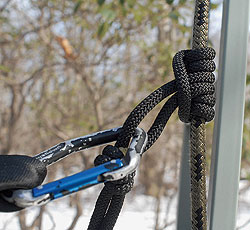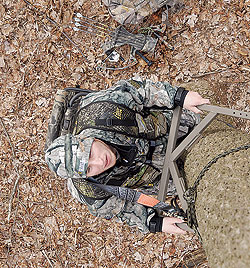October 28, 2010
"This isn't how it's supposed to be," I thought to myself as daylight broke on the first morning of my first guided bowhunt in Virginia back in the early '90s.
By P.J. Reilly
"This isn't how it's supposed to be," I thought to myself as daylight broke on the first morning of my first guided bowhunt in Virginia back in the early '90s.
I should have been full of anticipation and excitement. I should have been envisioning a trophy buck chasing a doe within spitting distance of my stand at any second. Instead, I was scared to death.
Advertisement
If a trophy buck did show up, he was going to have a free pass, because there was no way I was going to move a muscle, let alone stand up and draw my bow. The slightest shift in my weight to the right or left caused the hanging treestand I was in to cant several inches in that direction.
As best I could tell, the platform was resting on a limb and the chain attaching the stand to the tree wasn't taut. Sitting perfectly still was the only way I could keep the stand from moving. True, I didn't have a whole lot of bowhunting experience at that time. But even with my limited knowledge, I was pretty sure there was no way to draw a bow without moving.
Advertisement
So I climbed down, sat on the ground and saw nothing. When the guide picked me up for lunch, my instructions to him for the afternoon hunt were simple -- Don't put me in that stand again.
"I've hunted with a lot of outfitters in a lot of places, and one thing that always amazes me is the lack of attention to safety when they hang their stands," said Jim Barta, vice president of Hunter Safety System. "And it's not just outfitters. A lot of hunters are the same way with their own stands."
 A close-up look at the prussic knot on a commercially made lifeline. Hunters can also create their own lifelines using quality climbing rope and a properly tied prussic knot. |
Good statistics on treestand accidents are hard to find, but many state wildlife agencies claim one in three treestand hunters will fall at some time during their hunting careers.
The falls might be caused by equipment failure, hunters losing their balance or a host of other reasons. Regardless of how a hunter falls, 82 percent of those injured are found not to be wearing any type of fall restraint device, according to the Treestand Manufacturers Association.
Such was the case for 46-year-old bowhunter Joseph Philip Adams. On Sept. 20, 2008, Maryland's Department of Natural Resources (DNR) reported Adams was not wearing a safety harness while hunting deer from his treestand in Anne Arundel County. Adams fell approximately 15 feet to the ground during the hunt.
A friend heard Adams call for help, and the friend called 911 after finding Adams lying on the ground, unresponsive, DNR officials reported. Adams was transported to the Anne Arundel Medical Center, where he was pronounced dead.
"I've heard all the excuses for not wearing a safety harness," Barta said. "'They're not comfortable. They get in the way. It takes extra time to put them on.' First of all, what's your life worth compared to these excuses? And second, with the harnesses that are on the market today, none of these excuses are accurate any more.
"There's nothing you can do in a treestand without a harness on that you can't do with one on -- except fall."
A Troubling Trend
Last year, the National Bowhunter Education Foundation (NBEF) partnered with the hunting industry, state and federal wildlife agencies, medical organizations and first responders to launch Project STAND (Stop Treestand Accidents 'N Deaths), a national safety education campaign.
 You can't fall out of a climbing stand if you're attached to the tree from the ground up. |
It's a much-needed initiative considering the results of a recent study conducted by a team of doctors from Geisinger Health System in Danville, Pa. Their effort examined reported treestand accidents in Pennsylvania from 1987-2001. The doctors found that during that period, at least 280 hunters were injured in falls from treestands, and six of them died. (The study noted there was incomplete information on the use of safety restraints in these incidents.) Only hunters who received care from trauma centers across the state were counted for the study. It's a virtual certainty many other hunters fell and either did not seek medical care or received it somewhere other than a trauma center.
The overall injury rate for the study period was 1.9 per 100,000 hunters. But the annual rate of falls resulting in injuries grew from a low of 0.7 per 100,000 in 1987 to 4.8 per 100,000 in 2001. So, injury accidents appear to be on the rise. Project STAND officials don't think that's a trend unique to Pennsylvania.
"There's a preponderance of treestand usage all over the country right now, and it appears that the number of incidents is growing," said Marilyn Bentz, NBEF's executive director.
Bentz blamed most treestand accidents on the "bulletproof mentality."
"It's the hunters who think, 'I don't need to wear a safety harness,' or 'I don't need to read the instructions for this stand,' who often times end up getting hurt," she said. "They think accidents won't happen to them."
Project STAND offers a training course that teaches hunter education instructors about the safe and proper use of the various types of treestands -- ladders, hang-ons and climbers. As of February, nearly 300 people had completed the course.
"It's a train the trainer program," said Bentz, who is a Project STAND instructor. "Then the students can take what they've learned and plug it into their own hunter education classes."
With nearly 1 million new treestands being sold every year, Bentz said it's time hunter-education classes include a component about treestand safety.
"Hunters started taking to the trees in the 1970s," she said. "But there weren't a whole lot of treestand manufacturers around until the explosion
in the mid-1990s. Since 2000, the cost of treestands has gone down, and it's now common for one hunter to own five or six stands."
Craig Dougherty, a Quality Deer Management Association national board member who helped create Project STAND, said hunters need to respect treestands the same way they respect firearms.
"Quite frankly, I don't think it's been stressed enough that these things are dangerous," he said. "That doesn't mean hunters should be afraid of treestands, but they should respect them and understand the risks involved with climbing 20 feet up a tree. If they do that, I think we'll see more of them taking treestand safety seriously."
Everyone in the treestand business agrees the first step to being safe in a stand is wearing a full-body safety harness. Simply put, you can't hit the ground if you're attached to the tree. Convincing every hunter to take that first step, however, is a challenge, Barta said.
"It's a lot like wearing a seat belt in your car," he said. "The seat belts were always there, but nobody wore them until it was the law because they felt constricted and uncomfortable. The law got them accustomed to wearing seat belts, and now people don't feel comfortable unless they are wearing it."
But wearing a safety harness isn't a silver bullet when it comes to treestand safety.
Making sure your stands are installed and used correctly also is critical. "Treestand safety is a lot more than just wearing a harness," Dougherty said. "If your harness comes into play, that means something else has already gone wrong."
